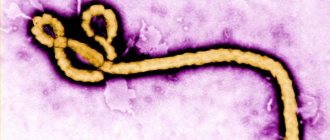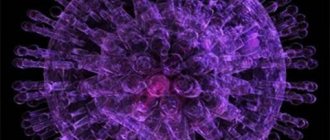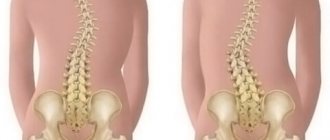Even 20-30 years ago, the Epstein Barr virus was associated only with acute mononucleosis and was treated by infectious disease specialists with antibacterial drugs. And only in recent years have they begun to notice that in some patients the disease can develop into chronic fatigue syndrome and even, although rarely, there is the possibility of developing a malignant blood disease.
In some cases, diagnostics are of great importance - otherwise therapy can go in the wrong direction and seriously harm the patient’s body.
EBV is the fourth type of herpes virus, the most common cause of chronic persistent infection from the group of herpes viruses.
Diseases caused by EBV
Epstein-Barr viral infection usually occurs in children and young adults. However, they can be observed at any age. The clinical manifestations of the infection are extremely diverse and have varied symptoms, which greatly complicates diagnosis. As a rule, manifestations of EBV develop against the background of decreased immunity, which is characteristic of all herpesvirus infections. Primary forms of the disease and its relapses are always associated with congenital or acquired immunodeficiency. People with severe immunodeficiency experience generalized forms of infection affecting the central nervous system, liver, lungs and kidneys. Often, severe forms of EBV infection may be associated with HIV infection.
How to treat Epstein-Barr virus
There is no specific treatment for EBV. Typically, treatment for Epstein-Barr virus involves eliminating symptoms. The patient needs to drink enough fluids, take antipyretic and painkillers, interferons, antiviral drugs, antibiotics (only if there is a viral sore throat or bacterial complications), corticosteroids. You need to get plenty of rest and reduce physical activity. If a person has a severe form of EBV, doctors prescribe medications against herpes infection.
Course of EBV infection
In people with normal immunity, after infection with EBV, two options are possible. The infection may be asymptomatic or manifest itself in the form of minor symptoms resembling influenza or acute respiratory viral disease (ARVI). However, in case of infection against the background of an existing immunodeficiency, the patient may develop a picture of infectious mononucleosis.
In the event of the development of an acute infectious process, several options for the outcome of the disease are possible: – recovery (DNA of the virus can be detected only with a special study in single B-lymphocytes or epithelial cells); – asymptomatic virus carriage or latent infection (the virus is determined in saliva or lymphocytes in the laboratory); – development of a chronic relapsing process: a) chronic active EBV infection of the type of chronic infectious mononucleosis; b) a generalized form of chronic active EBV infection with damage to the central nervous system, myocardium, kidneys, etc.; c) erased or atypical forms of EBV infection: prolonged low-grade fever of unknown origin, recurrent bacterial, fungal, often mixed infections of the respiratory and gastrointestinal tract, furunculosis; d) development of oncological diseases (Burkitt's lymphoma, nasopharyngeal carcinoma, etc.); e) development of autoimmune diseases; f) EBV-associated chronic fatigue syndrome.
The outcome of an acute infection caused by EBV depends on the presence and severity of immune deficiency, as well as on the presence of a number of external factors (stress, concomitant infections, surgical interventions, hyperinsolation, hypothermia, etc.) that can disrupt the functioning of the immune system.
How to diagnose Epstein-Barr virus
To identify EBV in the body, the doctor collects an epidemiological history, takes into account the clinical picture of the disease and refers the patient to certain tests. Typically, laboratory diagnosis of EBV includes the following markers:
- Epstein-Barr virus, determination of DNA in blood (Epstein Barr virus, DNA);
- Epstein-Barr virus, DNA determination in scrapings of epithelial cells of the nasal mucosa (Epstein Barr virus, DNA);
- Epstein-Barr virus, DNA determination in scrapings of epithelial cells of the oropharynx (Epstein Barr virus, DNA);
- Epstein-Barr virus, determination of DNA in blood serum (Epstein Barr virus, DNA);
- Epstein-Barr virus, determination of DNA in saliva (Epstein Barr virus, DNA);
- Epstein-Barr virus, determination of DNA in saliva (Epstein Barr virus, DNA);
- Epstein-Barr virus, determination of DNA in prostate secretion, ejaculate (Epstein Barr virus, DNA);
- IgG class antibodies to the nuclear antigen of the Epstein-Barr virus (EBV NA IgG, Epstein-Barr Virus Nuclear Antigen IgG, EBNA IgG);
- IgM class antibodies to the capsid antigen of the Epstein–Barr virus (EBV VCA-IgM, Epstein-Barr Virus Capcid Antigen IgM, EBV VCA-IgM);
- IgG class antibodies to the capsid antigen of the Epstein-Barr virus (anti-Epstein-Barr viral capsid antigens IgG, EBV VCA IgG);
- IgG class antibodies to the early antigen of the Epstein-Barr virus (anti-EBV EA-D IgG; Epstein-Barr Virus Antibody to Early D Antigen (EA-D), IgG; anti-EBV EA-D IgG).
Only a doctor can tell which of the above tests should be taken for a patient with suspected Epstein-Barr virus. Diagnosis and treatment should be carried out by a therapist, pediatrician or infectious disease specialist. If a patient has one or more lymph nodes enlarged, he constantly feels tired, coughs for a long time, the abdomen is enlarged, there is pain in the abdomen or bones, a consultation with a hematologist, oncologist and other specialists is needed.
Symptoms of viral mononucleosis
Photos from open sources
Clinical manifestations of EBV infection
Clinical manifestations of diseases caused by EBV largely depend on the severity of the process. The primacy of the infectious process or the occurrence of clinical symptoms of chronic infection is also important. In the case of the development of an acute infectious process due to EBV infection, a picture of infectious mononucleosis is observed. It usually occurs in children and young adults.
The development of this disease leads to the appearance of the following clinical signs: – increased temperature, – enlargement of various groups of lymph nodes, – damage to the tonsils and hyperemia of the pharynx. Quite often there is swelling of the face and neck, as well as an enlargement of the liver and spleen.
In the case of chronically active EBV infection, a long-term relapsing course of the disease is observed. Patients are concerned about: weakness, sweating, often pain in muscles and joints, the presence of various skin rashes, cough, discomfort in the throat, pain and heaviness in the right hypochondrium, headaches, dizziness, emotional lability, depressive disorders, sleep disturbances, decreased memory, attention , intelligence. Low-grade fever, enlarged lymph nodes and hepatosplenomegaly of varying severity are often observed. Usually this symptomatology has a wave-like character.
In patients with severe immune deficiency, generalized forms of EBV infection may occur with damage to the central and peripheral nervous systems (the development of meningitis, encephalitis, cerebellar ataxia, polyradiculoneuritis), as well as damage to other internal organs (the development of myocarditis, glomerulonephritis, lymphocytic interstitial pneumonitis, severe forms of hepatitis). Generalized forms of EBV infection can be fatal.
Quite often, chronic EBV infection proceeds silently or may resemble other chronic diseases. With erased forms of infection, the patient may be bothered by wave-like low-grade fever, pain in the muscles and lymph nodes, weakness, and sleep disturbances. In the case of an infectious process under the guise of another disease, the most important signs are: duration of symptoms and resistance to therapy.
Relevance
One of the pressing problems of modern medicine is the high incidence of herpesvirus infections, which are quite widespread in the human population.
The complex structure of the genome of viruses of the herpes family, compared to other DNA-containing viruses, determines the main differences in their replication cycle. Genes encoding structural proteins make up only 15% of the DNA in herpes viruses, while the majority of the genome consists of areas responsible for the synthesis of regulatory proteins and enzymes, and it is this feature that allows them to implement a completely unique program, including the possibility of a latent, persistent and reactivated state in infected organism [1]. A special place among herpes viruses is occupied by Epstein-Barr virus (EBV), which infects 95% of the population and, like all herpes viruses, it is capable of infecting almost all organs and systems of the body, causing latent, acute and chronic forms of infection, prone to reactivation in conditions of immunosuppression . Active proliferation of the virus in all organs and systems that have lymphoid tissue leads to structural changes that have an adverse effect on the body as a whole. The key role of EBV in the development of diseases such as acute and chronic mononucleosis, interstitial pneumonitis, myocarditis, hepatitis, tumors of lymphoid and epithelial tissues, hemophagocytic lymphohistiocytosis, leukoplakia of the tongue and post-transplantation lymphoproliferative complications has been proven.
Laboratory research
Considering that it is impossible to make a clinical diagnosis of EBV infection, laboratory diagnostic methods are leading in determining the disease.
They can be divided into two groups: screening and clarifying:
1. Screening tests include those that, along with clinical symptoms, allow one to suspect EBV infection. In a clinical blood test: slight leukocytosis, lymphomonocytosis, possibly thrombocytopenia may be observed. A biochemical blood test reveals: increased levels of transaminases and other enzymes, acute phase proteins - C-reactive protein, fibrinogen, etc. However, these changes are not strictly specific to EBV infection (they can also be detected in other viral infections).
2. An important study to determine the presence of a pathogen in the body is a serological examination: an increase in titers of antibodies to EBV is a criterion for the presence of an infectious process at the present time or evidence of contact with an infection in the past. However, the presence of antibodies does not allow us to say unambiguously that the clinical manifestations of the disease are caused by EBV.
3. To obtain the most reliable results, DNA diagnostics is used. Using the polymerase chain reaction (PCR) method, EBV DNA is determined in various biological materials: saliva, blood serum, leukocytes and peripheral blood lymphocytes. If necessary, research is carried out in biopsy samples of the liver, lymph nodes, intestinal mucosa, etc. Thus, to make a diagnosis of EBV infection, in addition to general clinical examinations, serological tests (ELISA) and DNA diagnostics of infection in various materials over time are necessary.
Treatment of EBV infection
Currently, there are no generally accepted treatment regimens for EBV infection. The volume of therapy for patients with both acute and chronic active EBV infection may vary, depending on the duration of the disease, the severity of the condition and immune disorders. In the complex treatment of this disease, various groups of drugs are used, including recombinant interferons, which suppress the reproduction of the virus, protect uninfected cells, and strengthen the immune system. In addition, acyclic synthetic nucleosides and other antiviral drugs are used to stop virus replication in the affected cells, as well as glucocorticoids, the action of which is aimed at stopping inflammatory processes in organs and tissues. Depending on the severity of certain symptoms of the disease, various symptomatic therapy is prescribed (analgesics, antioxidants, non-steroidal anti-inflammatory drugs, mucolytics, etc.).
Novirin
Novirin has an increased interferon content, so it has a direct antiviral effect. You can buy Novirin in syrup and tablets. Novirin is prescribed for influenza, adenoviruses, mumps, measles, viral bronchitis, herpes, Epstein-Barr virus, hepatitis B, papillomavirus and cytomegalovirus. "Novirin" is also indicated for urinary tract infections. Contraindications include renal failure, urolithiasis, gout. "Novirin" is not suitable for treating children under one year old, pregnant and breastfeeding women.
Novirin
PJSC “Kyiv Vitamin Plant”, Ukraine
Novirin is a direct-acting antiviral drug.
Novirin contains inosine pranobex (a complex molecular complex of inosine; N,N-dimethylamino-2-propanol; p-acetamidobenzoic acid in a ratio of 1:3:3), which has a pronounced immunomodulatory and antiviral effect. Novirin has a direct antiviral effect, which is caused by the binding of the active substance to the ribosomes of infected cells, as a result of which the processes of synthesis of viral mRNA and the replication of RNA and DNA genomic viruses slow down. from 800
5.0 1 review
393
- Like
- Write a review
Interferon in the treatment of disease
The drug of choice for the treatment of EBV infection may be interferon-alpha, which in moderate cases is prescribed as monotherapy. The rationale for including antiviral immune agents (interferons) in the therapeutic complex is that clinical manifestations of infection are usually associated with immunodeficiency states of varying severity. With EBV infection, there is always a reduced production of its own interferon. Considering that EBV infection is a chronic, persistent disease, interferon therapy can also be recommended as a prevention of exacerbations. In this case, a course of treatment is prescribed, the duration of which depends on the severity of the disease.
From the group of recombinant interferons, the drug VIFERON® Suppositories can be prescribed. The combination of the main active ingredient interferon alpha-2b and highly active antioxidants: alpha-tocopherol acetate and ascorbic acid (presented in the dosage form as a mixture of ascorbic acid/sodium ascorbate) allows you to reduce the therapeutically effective concentration of interferon alpha-2b and avoid the side effects of interferon therapy. In the presence of ascorbic acid and its salt and alpha-tocopherol acetate, the specific antiviral activity of interferon increases, its immunomodulatory effect is enhanced and interferon levels are normalized.
Treatment of EBV infection must be carried out under the supervision of a clinical blood test (once every 7-14 days), a biochemical analysis (once a month, more often if necessary), and an immunological study - after one to two months.
Reference and information material
Author of the article
Khaldin Alexey Anatolievich
Dermatovenerologist, clinical immunologist, MD, professor
Loading...
Take other surveys







